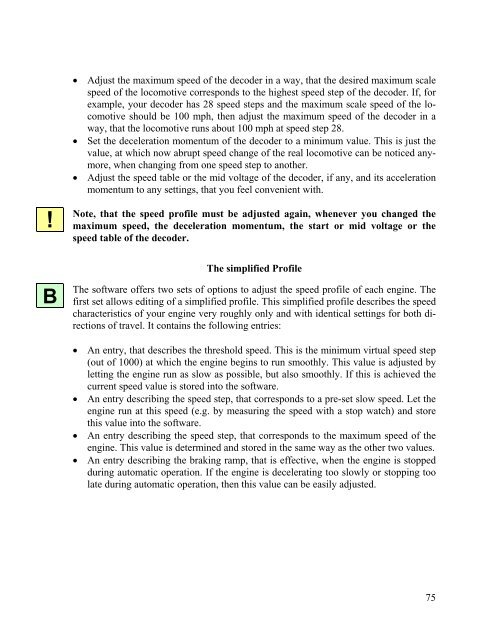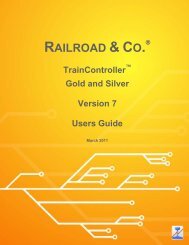Download - Freiwald Software
Download - Freiwald Software
Download - Freiwald Software
You also want an ePaper? Increase the reach of your titles
YUMPU automatically turns print PDFs into web optimized ePapers that Google loves.
!<br />
B<br />
• Adjust the maximum speed of the decoder in a way, that the desired maximum scale<br />
speed of the locomotive corresponds to the highest speed step of the decoder. If, for<br />
example, your decoder has 28 speed steps and the maximum scale speed of the locomotive<br />
should be 100 mph, then adjust the maximum speed of the decoder in a<br />
way, that the locomotive runs about 100 mph at speed step 28.<br />
• Set the deceleration momentum of the decoder to a minimum value. This is just the<br />
value, at which now abrupt speed change of the real locomotive can be noticed anymore,<br />
when changing from one speed step to another.<br />
• Adjust the speed table or the mid voltage of the decoder, if any, and its acceleration<br />
momentum to any settings, that you feel convenient with.<br />
Note, that the speed profile must be adjusted again, whenever you changed the<br />
maximum speed, the deceleration momentum, the start or mid voltage or the<br />
speed table of the decoder.<br />
The simplified Profile<br />
The software offers two sets of options to adjust the speed profile of each engine. The<br />
first set allows editing of a simplified profile. This simplified profile describes the speed<br />
characteristics of your engine very roughly only and with identical settings for both directions<br />
of travel. It contains the following entries:<br />
• An entry, that describes the threshold speed. This is the minimum virtual speed step<br />
(out of 1000) at which the engine begins to run smoothly. This value is adjusted by<br />
letting the engine run as slow as possible, but also smoothly. If this is achieved the<br />
current speed value is stored into the software.<br />
• An entry describing the speed step, that corresponds to a pre-set slow speed. Let the<br />
engine run at this speed (e.g. by measuring the speed with a stop watch) and store<br />
this value into the software.<br />
• An entry describing the speed step, that corresponds to the maximum speed of the<br />
engine. This value is determined and stored in the same way as the other two values.<br />
• An entry describing the braking ramp, that is effective, when the engine is stopped<br />
during automatic operation. If the engine is decelerating too slowly or stopping too<br />
late during automatic operation, then this value can be easily adjusted.<br />
75










